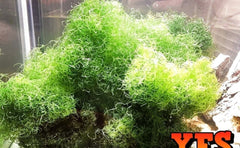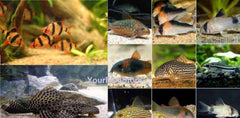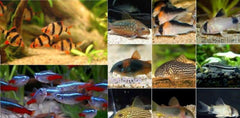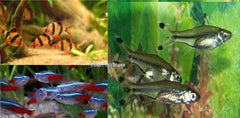X2 Red Tailed Pleco Sml/Med 1"-2" Tank Cleaners!
Ebay
$ 130.53

X2 RED TAILED PLECO SM/MD 1"-2" TANK CLEANERS! LIVE FISH - FREE SHIPPING
Common Names : Suckerfish, Suckermouth Catfish
Care Level : Easy to moderate
Size : Up to 18 inches (46 cm)
pH : 6.5 - 7.5
Temperature : 73°F - 82°F (23°C - 28°C)
Water Hardness : 5° to 19° dH,
Lifespan : 10 - 15 years
Origin / Habitat : South America
Temperament / Behavior : Generally peaceful, but plecos can be aggressive toward others of the same species.
Pleco Breeding : It can be very difficult to breed them in a home aquarium.
Introduction to Plecos
Pleco is a name used for the catfishes of the family Loricariidae . One of the species in this family is named Hypostomus plecostomus and the name Pleco is derived from the name of this species. Today, the name Pleco is used not only for Hypostomus plecostomus but for all the members of the family Loricariidae . Plecos are also known as armored catfishes, since the longitudinal rows of scutes present on the upper part of the fish resembles old-fashion armor.
If you purchase a Common Pleco in a fish store it can be one of several species, including Suckermouth Catfish ( Hypostomus plecostomus ), Bristlenose Catfish ( Ancistrus dolichopterus ), Sailfin Catfish ( Liposarcus multiradiatus ) or Amazon sailfin catfish ( Liposarcus pardalis ). The name Common Pleco is used for a lot of different brown-mottled Plecos that grow rather big in the aquarium. They all have similar habits and requirements, so this article is of interest even if you do not know exactly which species of pleco you keep.
The maximal lifespan of common plecos is not known, but it is believed to be around 20-30 years in captivity.
Pleco size
The fish sold under the name Common Pleco in fish stores is normally no bigger than 5-10 cm (2-4 inches) but this doesn’t mean that it will stay like that forever. Unfortunately, a lot of aquarists purchase fish without first finding out how big they can get as adults. In the case of the common pleco, you should expect your fish to eventually reach a size of 30-60 cm (1-2 feet).
Pleco habits
The common plecos are nocturnal creatures that are quite passive during the day. As long as the aquarium is lit, the pleco will use its specialized omega iris to keep the light from entering its eyes. When the lights are turned off in the evening, the omega iris will open and the fish will start searching for food.
Pleco temperament and suitable tank mates
Unlike many other plecos, the species normally sold under the name Common pleco are territorial and keeping two or more large Common plecos together is rarely it good idea. It might work out fine, but you are definitely taking a risk and you should be prepared to evacuate promptly if they fail to tolerate each other. Different individuals have different temperaments and the temperament can also change gradually as the fish ages. The risk for violence is probably lower if you combine large common plecos from different species with each other, but more research is necessary before we can say anything for sure. An interesting exception is the Bristlenose catfish ( Ancistrus dolichopterus ), a lot of aquarists have managed to keep more than one Bristlenose catfish in the same aquarium (regardless of fish size).
A lot of different fish species can be housed together with Common pleco, but fat or flat bodied fish – such as goldfish and discus – should be avoided since plecos are found of sucking on such fishes.
Aquarium for common pleco
Aquarium size
Since the species sold under the name common pleco can become so big, the fishes will eventually need big aquariums. If you purchase common pleco for your small aquarium you must therefore be prepared to eventually get a bigger aquarium or find a new home for your common pleco. Large adult specimens normally need at least 200 – 375 litres (roughly 50 – 100 gallons) since they can reach a length of 30-60 cm (roughly 1-2 feet).
Use a lid!
It is important to cover the aquarium when keeping common pleco because they are capable jumpers. In the wild, plecos can use this ability to escape to better conditions during dry periods. They can not really travel on land, but they are strong enough to wiggle their way from a shallow puddle to deeper puddle in a drying riverbed. To a certain extent, they are capable of absorbing oxygen directly from the air so they will last longer on land than many other fish. If you come home and find your pleco seemingly unconscious on the floor, you should put it back in the aquarium because it might not be dead yet.
Do not let the water go all the way up to the lid, because the common pleco wants to be able to swim up to the surface and gulp air. The fish uses the air to control its buoyancy.
When you set up an aquarium for the common pleco it is important to keep in mind that this fish eats plants. If you wish to use live plants, pick really sturdy and fast growing species and keep your fingers crossed. You can for instance try java moss, java fern och some sturdy crinum species. Also keep in mind that plecos are fond of uprooting plants. Use heavy stones to secure the area around each plant or go for floating plants and plants that can be anchored to aquarium decoration instead of planted in the substrate. Last but not least, keep your common pleco well fed at all times. A pleco that is given plenty of yummy vegetables in the aquarium is less likely to devour the plants.
Keeping common pleco in a barren aquarium is not a good idea since this fish likes to have a safe place where it can stay hidden and rest during the day. Live plants are however by no means mandatory in a pleco aquarium since there are many other forms of decorations that can be used to construct borders, create hiding spaces and make the fish feel at home. You can for instance use flower pots, stones, caves and artificial plants. You should also ALWAYS include driftwood in the aquarium setup since the common pleco needs to chew on wood to stay happy and healthy.
Water conditions in the aquarium
The common pleco hails from fast moving waters and will therefore appreciate powerful water currents and high oxygen levels in the aquarium. The water temperature should be kept in the 20-28 degrees C (68-82 degrees F) range and rapid changes in water temperature should be avoided. Healthy common plecos are however quite resilient and can survive in both cooler and warmer conditions, at least for a while. The common pleco needs soft water and the pH-value should be kept in the 6.0-7.5 range (acidic to slightly alkaline).
The common pleco produces quite a lot of waste. Regularly vacuum up the faeces and change 30-50% of the water each week. If you allow the water quality in the aquarium to drop, it can make the pleco think that the dry season has started and that its home is about to dry out. In order to save itself, it might try to escape by jumping out of the aquarium. A desperate pleco can bash itself against the aquarium lid until it sustains severe injury or even dies.
Food for common pleco
The common pleco is famous for its ability to keep the aquarium algae free, but you should always supplement the natural algae growth with additional food to make sure that your common pleco receives all necessary nutrients. The pleco is an omnivorous species, but meaty food should only make up a small part of its diet. For small plecos, uneaten scraps of the meaty food you serve other omnivores in the aquarium will often be enough. Large plecos can be given shrimps and fish fillets once in a while.
Since the common pleco feed on algae and plant matter in the wild, it will appreciate algae and plant based food in the aquarium. You can for instance use spirulina tablets or wafers as a base. Spirulina flakes float and might therefore be gulped down by faster fish in the aquarium before the pleco gets at chance to find them. Some plecos will however learn to quickly swim up to the surface during feeding time.
In addition to dry prepared foods, give your common pleco some fresh fruits and vegetables. You can for instance serve cucumber, zucchini, squash and similar vegetables. Lettuce and other leafy vegetables are also highly appreciated. There is no need to boil of blanch fruits and vegetables. A practical way of feeding common pleco is to get a vegetable holder for the aquarium or make one using a clothes-pin or similar.
Last but not least, an aquarium where you keep common pleco should always include driftwood since the fish needs wood to chew on. Wood is an importance source of fibre for common plecos.
Breeding common pleco
Sexing common pleco
Sexing the common pleco is really tricky, but in some species the males tend to be smaller than the females and develop bigger barbells. Some sources claim that the chin barbells are somewhat smoother in females. The Bristlenose Catfish is fairly easy to sex since the females do not develop any “horns”.
Aquarium Size : Recommended to keep them in aquariums that are in the hundreds of gallons. Due to their potential adult size this is one of those species better left in the wild or kept in ponds. For the aquarium there are other smaller pleco species that are available. Smaller species include the Bristlenose pleco, the Gold Nugget pleco, Zebra pleco and the Clown pleco (linked in similar species below).
Pleco Tank Mates : Many, given the mostly peaceful nature of this fish.
Pleco Fish Disease : Freshwater Fish Disease - Diagnose, Symptoms and Treatment
Pleco Diet / Foods : Herbivore, try to supplement their diet with algae wafers
Tank Region : Bottom and the sides of the glass.
Gender : There are no visible differences between the male and female.
The name "plecostomus" means "folded mouth" Pleco is a common name for fish from the familyLoricariidae but has extended to the family Hypostomus plecostomus known as a sucker fish
Many types of suckermouth armoured catfishes remain undescribed. As a result, they are given a common name and an L-number designation until a new scientific name is agreed upon.
They are extremely popular in aquariums for their ability to clean tanks by eating algae growth and dead fish.
Plecos are omnivorous, but in the wild feed nocturnally mostly on plant material. During the day, their unusual omega irises block a lot of light out of their eyes, but they are usually open at night. They can roll their eyes within their sockets, giving the appearance of winking. Plecos are usually skittish and quickly hide whenever they sense danger.
Appearance:
All three suckermouth catfishes (family Loricariidae) in Florida have rows of bony plates covering all but their belly area. Sailfin catfish are distinguished by worm-like pattern of dark markings on the head over a dark-golden background; pectoral fins stout with rough surfaces resembling course sandpaper; disc-like, protrusible mouth is under the head, and used like a suction cup to attach and feed on algae; females tend to be smaller, and fish larger than 18 inches probably males; lifeless and hollowed-out 'armored' bodies sometimes seen on canal and lake banks
QUESTIONS & ANSWERS
Have a Question?
Be the first to ask a question about this.














